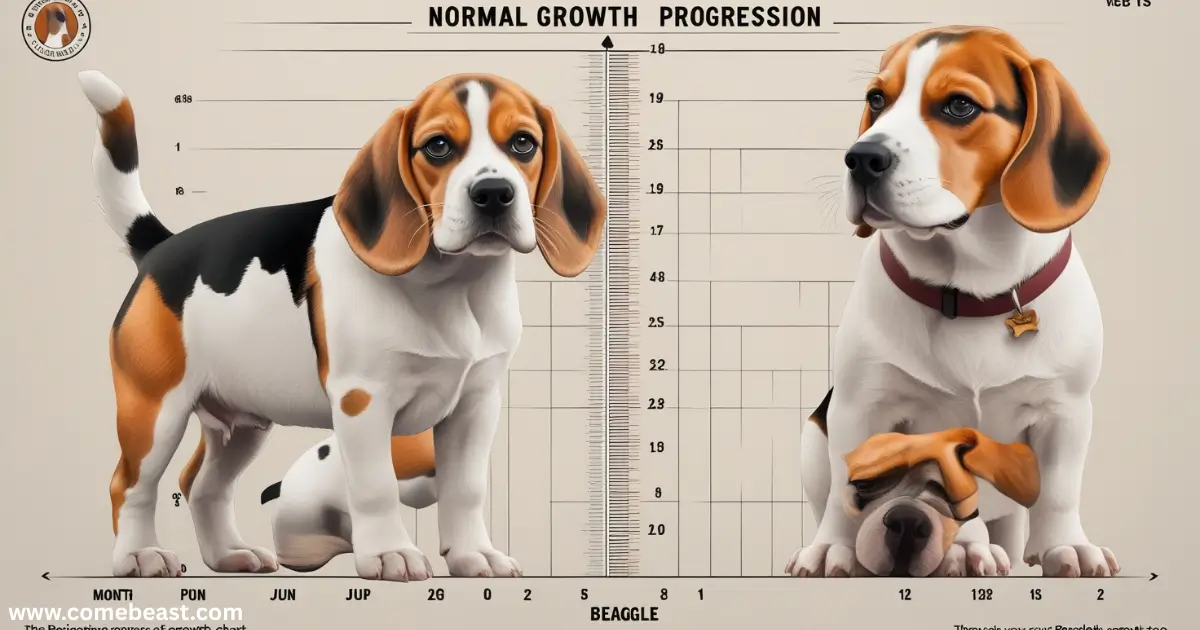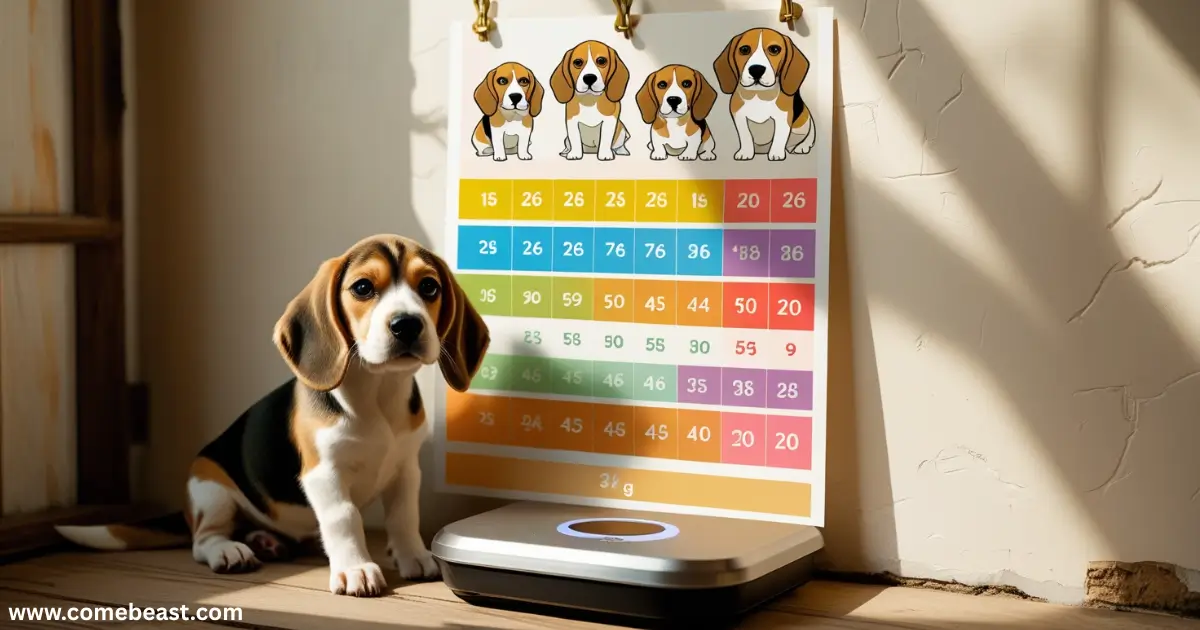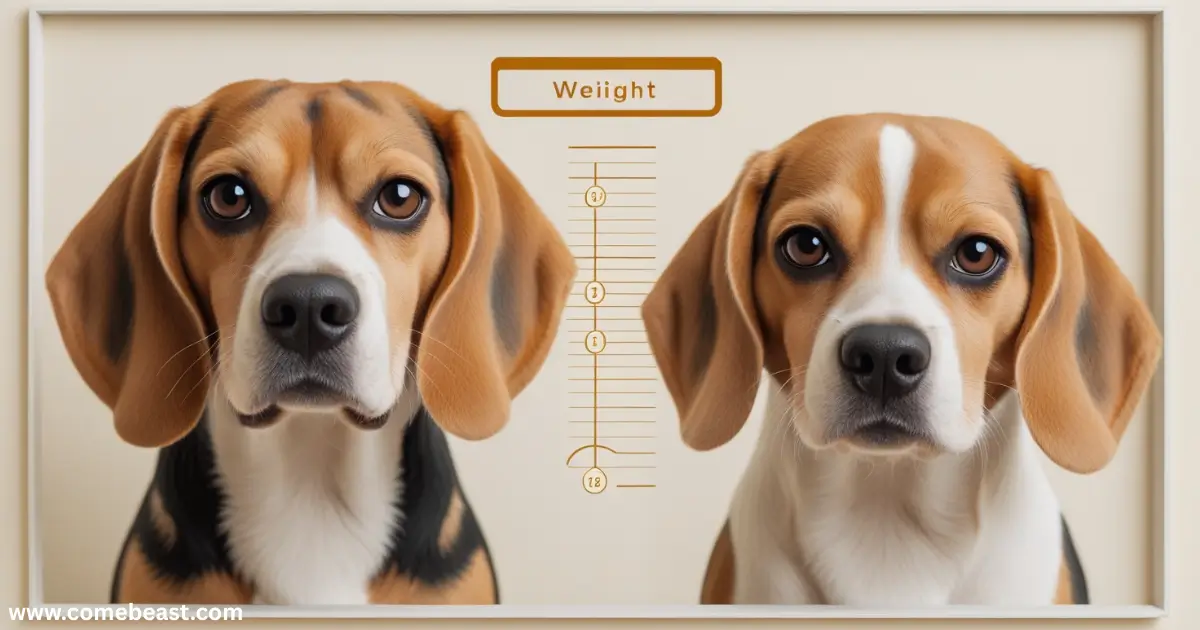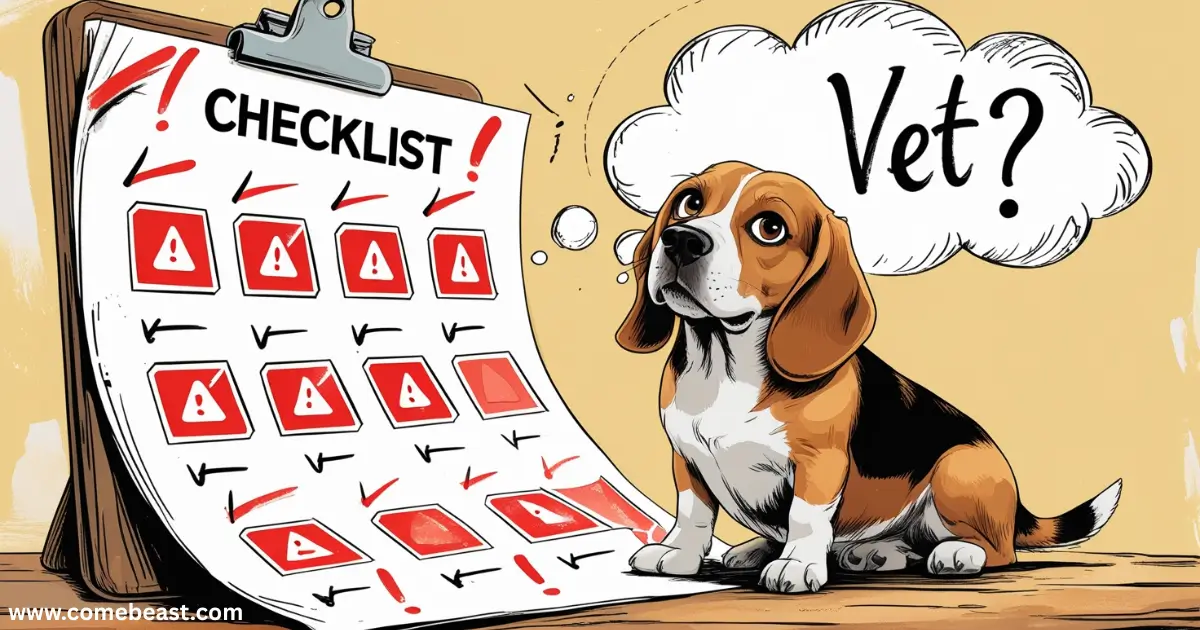Introduction: Why a Beagle Growth Chart Matters
A Beagle growth chart enables dog owners to check their puppy’s growth development effectively. Monitoring the growth of your child proves essential for his or her overall wellness. Weights as well as size and age information are presented on the specified chart. It is a guide, not a rule. But it helps a lot. This tool permits owners to discover potential troubles before they develop. Regular use of the Beagle growth chart will help maintain your Beagle puppy’s healthy development.
Normal growth progression of the Beagle is illustrated through its designated growth chart. Each month, puppies grow fast. The growth chart enables owners to recognize deviations from normal size in their puppies. Quick problem solutions become possible through this tool. Vets also use growth charts. So it helps your vet too. Through its usage your Beagle becomes both healthy and strong.

Understanding Beagle Growth Stages
Beagle puppies change fast. Each stage is different. You need to understand the sequence of changes that happen at specific stages. Supporting your dog properly becomes possible when you gain an understanding of their development. Growth is more than size. The process results in changes to both bones and brain and complete body growth.
Newborn to 8 Weeks
This is the start of life. Puppies are very small. They drink milk from mom. They sleep most of the day. They grow fast. Beagles reach between 4–6 pounds in weight at 8 weeks of age. After eye-opening they begin to walk properly until they start their first experiences of play. The majority of adults transition to new households at the 8-week mark.
2 to 6 Months
This is a big growth time. Beagles eat solid food now. They need 3–4 meals per day. Bones and muscles grow fast. Puppies gain weight every week. At six months old most Beagles carry weights ranging between 10 to 15 pounds. Their bodies now display characteristics of youthful canines.
6 to 12 Months
Growth slows down a bit. But it still happens. Beagles start to gain muscle. Their body requires additional exercise and movement. Their adult teeth come in. By 1 year, most weigh 18–25 pounds. They are almost full-grown.
1 Year and Older
Growth is slow now. But the dog still changes. Beagles get stronger bones. Their chest may get wider. Males grow a little longer. Most reach full size by 18 months. The finishing period for growth can extend until 2 years.
Beagle Puppy Growth Chart by Age
Using a chart enables you to track your puppy’s height and weight schedules throughout the months. This information provides expectation clarification. Normal numbers enable you to assess your dog’s development. All Beagles possess unique characteristics so each dog exhibits slight variations.

Beagle Weight Chart by Month
| Age | Weight (lbs) |
| 2 Months | 4 – 6 |
| 3 Months | 6 – 8 |
| 4 Months | 8 – 10 |
| 5 Months | 10 – 12 |
| 6 Months | 12 – 16 |
| 7 Months | 14 – 18 |
| 8 Months | 16 – 20 |
| 9 Months | 18 – 22 |
| 12 Months | 20 – 25 |
Use this chart monthly. Track your dog’s weight to stay on top of health.
Beagle Height Chart by Month
| Age | Height (inches) |
| 2 Months | 5 – 6 |
| 4 Months | 7 – 8 |
| 6 Months | 9 – 10 |
| 9 Months | 12 – 13 |
| 12 Months | 13 – 15 |
Height is from the ground to the shoulder. Use a soft tape to check it.
Average Adult Beagle Size
Most adult Beagles weigh 20–25 pounds. Their height is around 13–15 inches. Some are smaller. Pocket Beagles together with miniature Beagles represent the smallest type in this breed. A healthy adult Beagle ought to display a lean appearance instead of being overweight. These dogs should exhibit athletic movement and active behavior.
Full Grown Beagle Weight Range
Male Beagles are usually 22–25 pounds. Females may be 20–23 pounds. Active Beagles may be slimmer. Beagles reach full maturity over the time period from 12 to 18 months. Caring for Beagle fitness requires giving them healthy food and walking them daily.
Full Grown Beagle Height Range
A Beagle typically grows to 13 or 15 inches in height range. The Beagle breed comes in two different size variations. Both are healthy. Hunting purposes typically use the taller size of a Beagle dog. Pet Beagles most frequently come in the shorter size. Beagle dimensions are determined by bloodline inheritance.
Are Beagles Good Apartment Dogs? 7 Powerful Truths
Male vs Female Beagle Growth
Beagles of both sexes grow at different speeds during their development phase. Males are often bigger. But not always. Growth rates also vary. The sex of your Beagle provides better information about tracking their size measurements. Regular height and weight measurements are necessary throughout your Beagle puppy’s growth period.

Size Differences by Gender
Adult male Beagles commonly reach weights that are marginal than the female counterparts. A male Beagle tends to possess wider chest dimensions coupled with thicker neck structures. Female Beagles may remain within their smaller dimensions. The differences in size between male and female Beagles normally amount to 2–3 pounds. Few dogs do not obey the normal gender-based differences in size. It is essential to reference your growth chart on a regular basis.
Growth Rate Differences
Beagle male pups will normally show more rapid growth during their first period. Female Beagles have a tendency to stop their growth processes before their male counterparts. Females generally achieve their complete height during the period of 12–14 months. Males normally continue to develop their bodies up to 18 months of age. Checking for changes in physical development proves beneficial for observation. Beagles risk developing joint complications from their fast development rate. Keep meals and play balanced.
Beagle Body Condition Score (BCS)
The BCS measurement system covers a range from 1 to 9. The proper range for Beagle body condition score consists of 4 or 5 as the optimal marks. Such a body condition indicates the dog maintains a healthy weight. Owners should touch the ribs because they feel the bones although they remain invisible to the eyes.
An observable waist should be visible when looking down at the dog from above. The Body Condition Score system provides better health assessments than weighing alone.BCS provides better assessment compared to simply tracking weight because it evaluates body appearance while weight may not reflect total health and fitness.
Both Beagles with equivalent weight statuses may display different physical appearances. One might be fit. The other may be too fat. BCS helps spot this. The assessment method considers both the dog’s general form and weight measurement individually. A vet can score your dog. The procedure of evaluating BCS can be taught at home. It is easy and helps a lot.
How to Check BCS at Home
Feel your dog’s ribs. Light finger pressure marks should be sufficient to detect the ribs. Observe your Beagle while it sits atop a surface. There should be a waist. The belief should be above the body when you view your Beagle from its side. The body condition score becomes high when your Beagle becomes round and exhibits signs of obscure ribs.
Miniature Beagle Growth vs Standard
The short Beagles frequently go by the names mini or pocket Beagles among enthusiasts. Miniature Beagles represent only one group within the Beagle breed category. They have a stature that is below typical measurements. Their growth requirements along with their physical dimensions differ from one another. It is necessary to consult with a veterinarian when making your selection.
Key Size Differences
Miniature Beagles stop their growth at a usual weight between 10 and 15 pounds. The maximum height of miniature Beagles stays below thirteen inches. The growth rate of these dogs slows down while their food requirements decrease. Such small dogs still require the same level of attention when it comes to their care. Some breeding operations specialize in raising Beagles of reduced dimensions. A buyer must confirm the health of the Beagle before purchase.
What Is a Pocket Beagle?
The pocket Beagle results as a developed miniaturized form of its traditional lineage. Old hunting dogs used to fit into saddlebags which gives the name to pocket Beagles. Modern pocket Beagles possess actual cute dimensions. Problems with health appear because of problems during the breeding process. Only purchase a Beagle from trusted breeders who provide you with growth charts about the puppies.
Factors That Affect Beagle Growth
The growth patterns of Beagles vary from dog to dog. Many things shape their growth. The development of Beagles depends on food sources along with genetic factors and rest habits combined with exercise time. Some dogs grow slow. Others grow fast. Regularly observe your Beagle while referring to your Beagle growth chart.

Genetics and Breed Lines
Growth depends on parents. Big pet parents commonly get large offspring from their matings. Small parents make small pups. Lineage plays a role. Dogs demonstrate differences in their growth rate ranging from slow to fast. Inquire from your breeder about the typical size of puppies in their breeding program alongside their existing health conditions.
Nutrition and Feeding Habits
Food matters a lot. A bad diet restricts the natural growth rate of dogs. Too much food makes dogs fat. Use a vet-approved diet plan. Feed puppies 3–4 times a day. A proper diet plan should include two feedings per day as puppies advance in age. Always give fresh water.
Exercise and Play Time
Beagles need to move. Play helps bones grow strong. Walks help build muscle. Growth develops at a lower pace when exercise stays minimal. Too much can hurt joints. Puppies need rest too. Let them sleep after play.
Are Beagles Loud? 7 Powerful Facts Every Owner Must Know
How to Know If Your Beagle Is Growing Right
Regular observation must be your practice to detect indicators of proper growth. Weight accretion for the dog needs to happen gradually throughout time. The body should look fit. The legs should grow straight. The proper condition for your Beagle coat should include fullness with a shiny appearance. During daily routines the Beagle needs to stay active while being alert.
What Normal Growth Looks Like
The typical Beagle experiences a quick growth phase that lasts six months. Then slower after that. Through time the dog develops increased height and strength while becoming more energetic. Your Beagle’s development should become noticeable during every passing month. You need your Beagle growth chart to monitor growth progress. Steady growth is good growth.
Red Flags in Beagle Growth
Your puppy should experience meaningful growth over a period of weeks because static height and weight are indications of problems. You should examine the Beagle to spot any signs of weakness or tiredness given its current size. The condition of limping should make you suspect something is wrong. Excessive weight gain during a short time period may lead to joint problems in dogs. You need to immediately consult your veterinarian if you notice such symptoms.
Common Growth Issues in Beagles
The growth rate of a few Beagle puppies becomes slower than expected. Others may get too fat. Both are bad. Your assistance is necessary for their growth direction. Reference your growth chart for inspections every week. Look for changes. Catching problems early is key.

Stunted Growth
The puppy will experience slow growth from ingestions of bad food or from worm infestations or from being sick. This is called stunted growth. The puppy keeps a small or thin body. You may also see low energy. A vet visit is a must. Many dogs successfully recover when they receive proper care in combination with an improved food diet.
Overweight Beagle Puppies
Fat pups develop when puppies receive excessive treats combined with large meals. Overweight puppy growth results in an overweight adult dog. The combination of heart and joint issues develops because of this. The ribs should be detectable through touch but should not be visible. The portions of treats should be small while feeding your Beagle at scheduled times.
Healthy Beagle Puppy Weight Gain Tips
Your efforts at appropriate developmental care can result in healthy growth of your Beagle. Healthy puppy weight gain depends on using high-quality food during specific meal periods and regular physical activities. Don’t skip vet visits. Keep a chart. Your plan will direct your actions whenever unexpected changes occur. Standard measurements toward substantial health outcomes provide successful results.
Feeding Schedule by Age
Puppies shorter than three months should eat four times every day. Your Beagle puppy requires three meals each day from the third month to the sixth month of life. Moving forward after 6 months of age, feeding your Beagle puppy should consist of two meals per day.
Always give water. Use a set time. Don’t free-feed. Setting food times for the body helps maintain a proper rhythm between sleep cycles and wake cycles.The dietary elements which promote the development of strong growth in puppies form the topic of this section
The key nutritional components for proper puppy growth within their food should include protein coupled with fat and calcium. Pick trusted brands. Chicken along with fish or lamb should be present on the menu. No fillers. Avoid table food. Puppies also need vitamins. And fish oil chews can be added to your puppy’s diet according to your vet’s recommendation.
Growth Milestones and Development
The size increase of Beagle pups includes small developmental changes as well as major changes with their growth. Teeth come in. The body changes. The brain grows too. Being aware of the expected growth pattern is essential. Having this knowledge allows you to better get ready and conduct training sessions effectively.
When Do Beagles Lose Baby Teeth?
Beagles experience the replacement of their baby teeth between four to six months of age. This can make them chew more. Give chew toys. Keep cords away. Adult teeth are stronger. Your Beagle requires professional help from their vet if any baby teeth remain for too long.
When Do Beagles Stop Growing?
The growth progression of most Beagles ends between their first year to their second at around 12–18 months of age. The growth rate of certain Beagles stretches to last two years. You will notice smaller changes between weight measurement and height assessment. The important necessities for Beagles include quality nutrition and adequate physical movement together with adequate veterinary support.
Vet Checks and Growth Monitoring
Your vet helps track growth. They use charts and scores. The veterinarian examines bones along with teeth and heart during their assessment. Beagle veterinary visits involve more than basic vaccinations and do not limit to wellness checks only. Your Beagle requires proper veterinary care to maintain their durability from one life stage to the next.
What to Expect at Each Vet Visit
Your doctor performs a weight measurement procedure during every scheduled appointment. They will check body shape. The vet will probably inquire about the puppy’s food consumption and outdoor activities. The vet administration will conduct necessary tests when they detect any medical problem. Your growth chart needs to be shown to your veterinarian during every visit. It helps a lot.
Beagle Growth: What to Ask Vets
Consult your veterinarian about checking if the growth trajectory matches expectations. Ask about food and weight. Inquire about whether your Beagle has a typical size for its breed. You should consult with your vet for appropriate weight management strategies when you identify your Beagle having either a thin or heavy appearance. Write down the answers. It helps you stay on track.
Printable Beagle Growth Chart Tracker
The ability to write on a chart plays an important role in tracking. You can mark each month. Maintain a record which includes notes on food consumption and weight measurements and height assessment. Monitoring dog growth at home becomes straightforward because you will notice growth delays.
The growth tracker system simplifies both veterinary appointments and clinic visits.The process of tracking home growth involves weekly weighing your Beagle with either a step scale or a baby scale and subtracting your weight and recording the results each day at the same time.
Weekly weighing of your Beagle should become a regular habit. Weigh your Beagle weekly using a baby scale or measure your weight while standing with the dog on your residential scale. Subtract your weight. Use a soft tape for height. Write it down. To achieve optimal results measure your Beagle during the same daily period.
How Often to Weigh Your Puppy
Puppy growth should be tracked weekly instead of monthly. When your Beagle reaches one year you should measure their growth only once per month. Regular weighing should occur more frequently when the dog becomes unwell or stops food consumption. Regular observation must be accompanied by fast response time.
Conclusion: Using a Beagle Growth Chart the Right Way
The Beagle growth chart functions as a useful measurement instrument. Use it each week. Check weight, height, and body shape. Feed your dog well. Give it play and sleep. Talk to your vet often. Watch for red flags. All Beagles can grow healthier when they have robust muscles while enjoying energetic play which enables them to live many years.
FAQ: Beagle Growth Chart
When to Start Tracking Beagle Growth
Begin your Beagle growth monitoring process exactly when you choose to adopt the puppy home. The growth chart becomes usable already at week 8 for recording both weight and size measurements. Monitoring your Beagle from day one makes it simpler to identify any development changes that occur. Weekly checks work best.
Is Undersized Beagle Growth Still Normal?
Yes, it can be normal. Charts give a range. Your Beagle may grow slower. Health can be indicated through proper nutrition and plentiful exercise regardless of size disparities. Consult your vet whenever doubtful information arises. They can check for issues.
The fast growth of my Beagle becomes a concern.
Rapid growth during dog development leads to damage in bones and joints. Some dogs get hip problems. Feed your dog the right food. Don’t overfeed. You should prevent long-distance training sessions for dogs that are still young. A weight increase that seems too rapid requires veterinary consultation.
Is Your Beagle Carrying Extra Weight?
Feel the ribs. The ribs must be touchable although they should be out of sight. Look at the waist. It should curve in. A Beagle looks overweight if its shape is round or wide from the sides. To determine your dog’s body shape a veterinarian will utilize scoring techniques.
Do Mini Beagles Need Separate Chart?
Yes. The growth progression of Mini Beagles leads to lower size and slower development. Their size is below normal standards for both height and weight measurements. You should either create your own weight chart or consult with a professional veterinarian. It is wrong to evaluate the weight of miniature Beagles against that of regular Beagles. The numbers are different.





[…] Beagle Growth Chart: 5 Shocking Facts About Puppy Size […]
[…] Beagle Growth Chart: 5 Shocking Facts About Puppy Size […]
[…] Beagle Growth Chart: 5 Shocking Facts About Puppy Size […]
[…] Beagle Growth Chart: 5 Shocking Facts About Puppy Size […]
Loved this! I’m raising my first Beagle, and it’s so helpful to see the growth stages laid out like this. Super clear and easy to follow thank you!